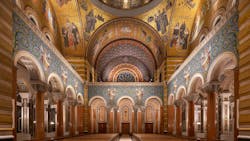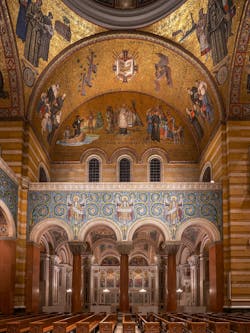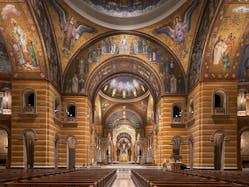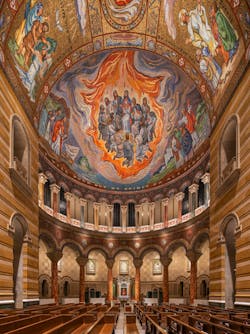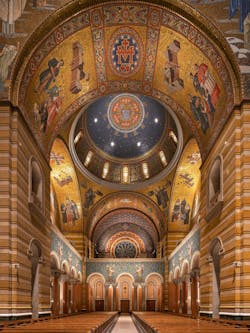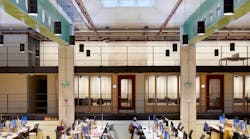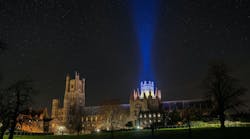Stunning mosaic artwork has adorned the walls and ceilings of the Cathedral Basilica of St. Louis for much of its 100-year history, yet failing fixtures limited even the task lighting parishioners relied on during services and obscured the spectacular view. Following an extensive lighting design renovation completed by Reed Burkett Lighting Design of St. Louis in late 2023, the beauty of more than 80,000 square feet of mosaic artwork is highlighted as never before.
Monsignor Henry Breier began working with Randy Burkett, a principal at RBLD, in 2019 to improve the less-than-optimal cathedral lighting. Burkett and his team performed several technical surveys at the cathedral, observing ambient conditions at different times of the day and during religious services and events. The team studied the mosaics, sculpture, artwork and architecture — and their interplay with light — to understand how and where each piece might be viewed to identify the optimal angles to introduce light.
Monsignor Breier, other clergy and facility team members were actively involved from the planning phase, noted Lisa J. Reed, a principal at RBLD. “During mockups, we would demonstrate multiple options for illuminating a particular mosaic —the pendentives, as an example — and they would view the options and offer their perspectives. They made lighting selections based on which option helped tell the story conveyed by a specific mosaic or piece of art. Having their input was quite helpful.”
Lighting design installed
Once designed, RBLD worked with St. Louis-based Schaeffer Electric to install the new lighting. “Ninety percent of the church is lit from one large light box above the center dome,” said Paul Krobath, in an article for St. Louis Magazine.
Because functional nave illumination was inadequate for services and events, a novel approach was needed, Reed said. “At the 140-foot center dome apex, an existing oculus was repurposed to accommodate an armature of (37) 200-watt LED narrow distribution floodlights. Each fixture was focused on a specific floor target through the ceiling’s aperture. The framework height was idealized to allow cross-aiming to 70% of the nave.”
In addition to better illuminating the basilica, the new lighting plan improved energy efficiency. “The original system was made up of over 50,000 watts of incandescent light,” Reed said. “This innovative design reduced power by 87% and tripled levels to 30 footcandles.”
When it served the lighting plan, existing fixtures were repurposed in the new scheme, Reed explained. “Existing ornamental lanterns became positions for new concealed LED modules, focusable to the ceiling and walls within. The canopy was highlighted from the central dome oculus.”
The ability to control lighting color temperature and optical precision were key features of the lighting design plan RBLD developed. Using 3000K color temperature LEDs ensured high color rendering.
Highlighting the artwork
“Illuminating the 22 million tiles demanded a variety of distributions, from 4 to 50 degrees, along with special optical spread lenses,” Reed said.
The extensive mosaics — 30 to 40 million tiles in total — incorporated polished and matte tiles. Multiple sources of light, from different angles, were used to manage reflections when viewing the glass tile art. “The reflective characteristics of the glass tesserae tiles made lighting angles critical to revealing the richness and texture of the mosaics. Hundreds of hours were spent experimenting with lighting positions throughout the cathedral. The Baldachin is adorned with mosaics both atop and within its structure,” Reed explained.
The extensive mosaics — on nearly every surface in the nave and chancel — meant the lighting of the mosaics defied the architectural form. “There was some limited embellishment of columns and other architectural highlights. Stations of the cross are sculptural, and those revealed through soft-edge accent lighting. The architectural dome surfaces were washed in light, along with mosaic accenting. The inward-facing dome windows are backlighted from an interstitial space between the outer and inner domes, so there is not as much direct daylight as you would expect.”
In addition to the mosaics, RBLD illuminated marble statues throughout the cathedral. “With sculpture, it is all about how you reveal the texture of the piece as well as the expressions and facial features to interpret the emotional impact that the artist intended,” Reed said. “The background behind any sculptural piece is also an important consideration which impacts its visibility. Dimming allowed for the establishing of visual hierarchies.”
To incorporate lighting without affecting the architectural elements, lighting rails were mounted along the backside of the walls in the galleries, Reed noted. “Many of the lighting instruments were attached to these rails to provide finetuning the accent angles. Existing architectural geometries within the galleries were exploited to position the lights in a way that made them invisible from the gallery.”
Similar techniques were used elsewhere in the basilica, Reed added. “We also located luminaires within the four towers at the corners of the main dome. Fixtures were concealed within arched openings in these towers as well, projecting accent light into the higher mosaic settings. Some of these instruments are visible, but they are located to minimize glare from normal viewing angles.”
Lighting controls provide flexibility
Monsignor Breier worked with the lighting controls vendor during commissioning to set his preferred scenes for the benefit of the worship services and parishioners, Reed noted. Controls allow church personnel to set customized scenes depending on how the cathedral is being used.
“All lighting for the cathedral is controlled through a centralized DMX system, with presets established for daily and special events. Docents leading tours use a wireless device to activate highlights that enhance the mosaic storytelling experience,” Reed said. The presets used by the docents highlight particular mosaics so they can talk about the history of those pieces.
These scenes differ from the presets used for a typical Mass, Reed added. “The levels don’t change significantly during Mass, but during music or other portions of the service when written material is needed, light levels are increased over the congregation.”
Editor’s note: In 2022, Envision Lighting Design, led by Lisa J. Reed, and Randy Burkett Lighting Design, led by Randy Burkett, merged their two St. Louis-based firms into Reed Burkett Lighting Design.
